Tips on Korean Food Ingredients You Can Buy at Korean Groceries
Korean Grocery Items for Cooking Korean Food
In major metropolitan areas in the United States, there are Korean grocery stores selling ingredients that are unique to Korean cuisine and other items broadly used in Asian foods. Although some American supermarkets also carry a few such items like soy sauce, tofu and green onion, you would eventually need to shop at Korean groceries if you want to make Korean dishes that require specialty items.
This page will explain some of the major Korean ingredients you can find in Korean groceries. We also have a special “Kimchi Section” at the bottom of this page.
For your quick reference, the food items covered in this page are listed below. You can either scroll down or click an item in the list to quickly jump to that section within this page.
One Essential Item
Fermented Sauce Pastes (Important in Korean Cuisine)
Red Pepper Paste (고추장: Gochujang)
Frequently Used Items for Seasoning
Red Pepper Flakes (고춧가루: Gochugaru)
Crushed Sesame (깨소금: Ggae Sogeum)
Vegetables
Soybean Sprouts (콩나물: Kong Namul)
Mung Bean Sprouts (숙주 나물: Sukju Namul)
Green Onion [Scallion] (파: Pa)
Korean Pepper (한국 고추: Hankuk Gochu)
Korean Sweet Potato (고구마: Goguma)
Tofu
Seaweeds
Noodles
Starch Noodle also known as Cellophane Noodle (당면: Dangmyeon)
Rice Cakes
Rice Cakes for Tteokbokki (떡볶이)
Kimchi
One Essential Item
Soy Sauce
(간장 : Ganjang)
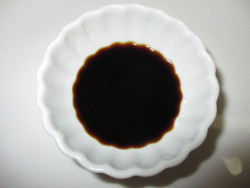 Soy sauce is a salty liquid sauce used in many Korean dishes including Bulgogi (Korean BBQ). This fermented soybean product is available at all American supermarkets. Korean groceries carry two different types of soy sauce.
Soy sauce is a salty liquid sauce used in many Korean dishes including Bulgogi (Korean BBQ). This fermented soybean product is available at all American supermarkets. Korean groceries carry two different types of soy sauce.
(a) General Use “Soy Sauce”
This type of soy sauce is not unique to Korean cuisine. It is the same black liquid sauce that you might have seen in Korean, Chinese or Japanese restaurants. The label on the bottle says “Soy Sauce” (along with the brand logo and other design elements). To begin your Korean cooking project, this is one item you absolutely need. Soy sauce is in plastic or glass bottles and stocked on room temperature shelves. An opened bottle can be kept at room temperature.
(b) Special Korean Soy Sauce Known as “Soup Soy Sauce” (국간장 : Guk Gan Jang)
This special soy sauce is a more ancient form of Korean soy sauce and gives a more subdued flavor compared to the general “soy sauce”. It is used for Korean soups (e.g., Miyeok Guk: 미역국) and also can be used for Namul. If you are a beginner in Korean cooking, you don’t need to buy this – you can use the general use “soy sauce” whenever soy sauce is called for. The label on a "Soup Soy Sauce" bottle may or may not have English writings on it. It is packaged in bottles and stocked on room temperature shelves. An opened bottle can be kept at room temperature.
* Korean groceries sell many brands of the two types of soy sauce as well as some variations (e.g., soy sauce with other seasoning ingredients added). If you can’t read the Korean labels, you may need assistance in choosing the right soy sauce. Or, as far as soy sauce is concerned, you may find it simpler to just buy a bottle of general use “soy sauce” at an American supermarket.
Fermented Sauce Pastes (Important in Korean Cuisine)
Red Pepper Paste
(고추장 : Gochujang)
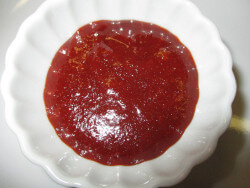 Gochujang is a red colored, hot paste, which is a fermented product made from red pepper flakes, sweet rice flour, fermented soybean, etc. It is packaged in plastic cartons and stocked on room temperature shelves. Once opened, keep the carton in the refrigerator.
Gochujang is a red colored, hot paste, which is a fermented product made from red pepper flakes, sweet rice flour, fermented soybean, etc. It is packaged in plastic cartons and stocked on room temperature shelves. Once opened, keep the carton in the refrigerator.
Gochujang is used in various dishes such as Tteokbokki (떡볶이). It is also the major component of Cho-Gochujang (초고추장), the vinegary hot sauce that is essential for such dishes as Bibimbap (비빔밥). (“Cho” means vinegar in Korean.)
Cho-Gochujang is made by mixing red pepper paste (Gochujang), vinegar and sugar. The ratio of the three ingredients is: 2.5 tablespoons of red pepper paste (Gochujang), 1 tablespoon of vinegar and 1 tablespoon of sugar. Note that the numbers given here only show the ratio. The actual amount of Cho-Gochujang you need may vary.
There are different levels of hotness in Gochujang, and the Korean food industry uses a standardized scale expressing the hotness, called GHU (Gochujang Hot Taste Unit). It has five levels: 1 (Mildly Hot); 2 (Slightly Hot); 3 (Medium Hot); 4 (Very Hot); 5 (Extremely Hot). This GHU number is usually shown on the package. Unless you have a particular preference for super-hot taste, it is recommended that you choose a Gochujang package with a GHU scale of 2, which is still quite hot with a rich flavor of Gochujang.
Chili or paprika cannot be a substitute for Korean red pepper, which is very different. For recipes calling for Korean red pepper products, do not use chili or paprika.
Soybean Paste
(된장 : Doenjang)
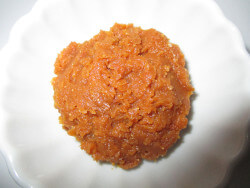 Doenjang is a yellow-brown paste, which is a fermented product made with soybean. The taste is mild because there is no red pepper in it. However, it is salty and you would not add additional salt to a dish, when soybean paste is used. It is packaged in plastic cartons and stocked on room temperature shelves. Once opened, keep the carton in the refrigerator. Soybean paste is used mostly in liquid-based dishes such as Guk, Jjigae, etc. Another use of Doenjang is mixing it with Gochujang and other ingredients to make Ssamjang, which is served along with side dishes to Bulgogi (Korean BBQ) and Galbi in restaurants. Unlike most other items described in this page, the taste of Doenjang varies widely from brand to brand. Unless you have a specific preference, the safest bet would be to choose one of the better-known brands.
Doenjang is a yellow-brown paste, which is a fermented product made with soybean. The taste is mild because there is no red pepper in it. However, it is salty and you would not add additional salt to a dish, when soybean paste is used. It is packaged in plastic cartons and stocked on room temperature shelves. Once opened, keep the carton in the refrigerator. Soybean paste is used mostly in liquid-based dishes such as Guk, Jjigae, etc. Another use of Doenjang is mixing it with Gochujang and other ingredients to make Ssamjang, which is served along with side dishes to Bulgogi (Korean BBQ) and Galbi in restaurants. Unlike most other items described in this page, the taste of Doenjang varies widely from brand to brand. Unless you have a specific preference, the safest bet would be to choose one of the better-known brands.
Frequently Used Items for Seasoning
Red Pepper Flakes
(고춧가루 : Gochugaru)
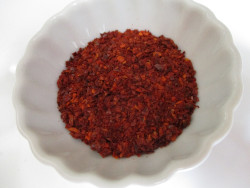 Red pepper flakes give the hot taste and red color to Kimchi and many other Korean foods. Gochugaru is packaged in small plastic bottles or large plastic bags and stocked on room temperature shelves. Keep an opened package at room temperature. Red pepper flakes from a new package have bright red color, and as time goes by, they will slowly lose freshness and the color turns darker. If you cook Korean food only occasionally, you may want to buy red pepper flakes packaged in small plastic bottles.
Red pepper flakes give the hot taste and red color to Kimchi and many other Korean foods. Gochugaru is packaged in small plastic bottles or large plastic bags and stocked on room temperature shelves. Keep an opened package at room temperature. Red pepper flakes from a new package have bright red color, and as time goes by, they will slowly lose freshness and the color turns darker. If you cook Korean food only occasionally, you may want to buy red pepper flakes packaged in small plastic bottles.
Chili or paprika cannot be a substitute for Korean red pepper, which is very different. For recipes calling for Korean red pepper flakes, do not use chili or paprika.
Sesame Oil
(참기름 : Cham Gireum)
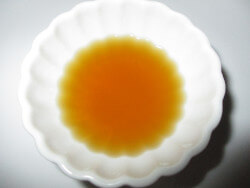
Sesame oil is used in Korean dishes as frequently as olive oil is used in Western cuisines. If you have a small bottle of sesame oil, you can make many Korean dishes truly authentic. For some dishes such as Bibimbap, sesame oil is obligatory. However, for many Korean foods that call for sesame oil, you can use vegetable oil instead, especially if you want to enjoy them along with American foods, since the flavor of sesame oil doesn’t go too well with Western foods.
Crushed Sesame
(깨소금 : Ggae Sogeum)
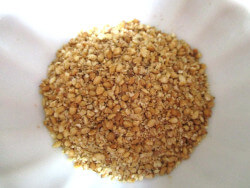 Sesame seeds are used in Namul and other dishes. Korean groceries stock two types of sesame seeds: whole and crushed (ground). Both types are packaged in small plastic bottles and stocked on room temperature shelves. Keep an open bottle at room temperature. The whole sesame seeds are sprinkled on Korean dishes as a final touch of presentation; for seasoning, a small amount is crushed each time using a mortar and pestle. If you make Korean food only occasionally, you may want to buy the pre-crushed type (pictured).
Sesame seeds are used in Namul and other dishes. Korean groceries stock two types of sesame seeds: whole and crushed (ground). Both types are packaged in small plastic bottles and stocked on room temperature shelves. Keep an open bottle at room temperature. The whole sesame seeds are sprinkled on Korean dishes as a final touch of presentation; for seasoning, a small amount is crushed each time using a mortar and pestle. If you make Korean food only occasionally, you may want to buy the pre-crushed type (pictured).
Vegetables
Korean Radish
(무 : Moo)
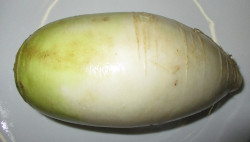 Western radishes are small and ball-shaped, but Asian (Korean and Japanese) radishes, sold at Korean groceries, are larger and longer. A Korean radish is slightly shorter and rounder than a Japanese radish. Even within one batch of Korean radishes in a store, the individual shapes are somewhat variable. How to Prepare: Rinse in cold running water. Peel the outer skin with a potato peeler (Korean radish has a relatively thick outer layer, which you don’t need to remove completely; just remove a thin layer using a potato peeler). Use a portion for cooking; wrap the remainder with plastic wrap and keep it in the refrigerator. A peeled Korean radish stays juicy in the refrigerator for up to a week or so. Korean radish is used for soups and various side dishes, as well as for several types of Radish Kimchi: Kkakdugi (깍두기 ) and Dong-Chi-Mi (동치미 ).
Western radishes are small and ball-shaped, but Asian (Korean and Japanese) radishes, sold at Korean groceries, are larger and longer. A Korean radish is slightly shorter and rounder than a Japanese radish. Even within one batch of Korean radishes in a store, the individual shapes are somewhat variable. How to Prepare: Rinse in cold running water. Peel the outer skin with a potato peeler (Korean radish has a relatively thick outer layer, which you don’t need to remove completely; just remove a thin layer using a potato peeler). Use a portion for cooking; wrap the remainder with plastic wrap and keep it in the refrigerator. A peeled Korean radish stays juicy in the refrigerator for up to a week or so. Korean radish is used for soups and various side dishes, as well as for several types of Radish Kimchi: Kkakdugi (깍두기 ) and Dong-Chi-Mi (동치미 ).
Napa Cabbage
(배추 : Baechu)
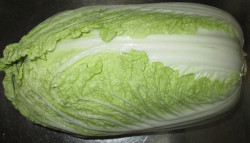 Napa Cabbage is used for making Kimchi. But it is also used in soups, stews, Jeon, etc. Some American supermarkets also carry Napa cabbage. For an example of a side dish made with Napa cabbage, see the recipe for Beef & Shrimp Jeon, which is in our Recipes Page.
Napa Cabbage is used for making Kimchi. But it is also used in soups, stews, Jeon, etc. Some American supermarkets also carry Napa cabbage. For an example of a side dish made with Napa cabbage, see the recipe for Beef & Shrimp Jeon, which is in our Recipes Page.
Soybean Sprouts
(콩나물 : Kong Namul)
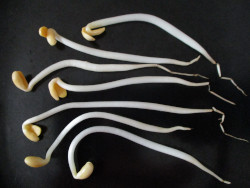 A soybean sprout has, in its head portion, a prominent yellow bean split into two halves. As examples of Korean dishes made with soybean sprouts, we have a Bibimbap recipe and Soybean Sprout Namul recipe in our Recipes Page. Soybean sprouts are also frequently added to various stews and soups, because of the special background flavor they lend.
A soybean sprout has, in its head portion, a prominent yellow bean split into two halves. As examples of Korean dishes made with soybean sprouts, we have a Bibimbap recipe and Soybean Sprout Namul recipe in our Recipes Page. Soybean sprouts are also frequently added to various stews and soups, because of the special background flavor they lend.
Mung Bean Sprouts
(숙주 나물 : Sukju Namul)
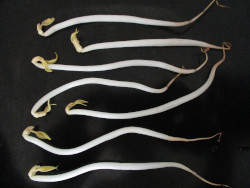 Compared to a soybean sprout, the head portion of a mung bean sprout has a smaller and less conspicuous bean. For preparation instructions, see the Mung Bean Sprout Namul Recipe in our Recipes Page.
Compared to a soybean sprout, the head portion of a mung bean sprout has a smaller and less conspicuous bean. For preparation instructions, see the Mung Bean Sprout Namul Recipe in our Recipes Page.
Green Onion [Scallion]
(파 : Pa)
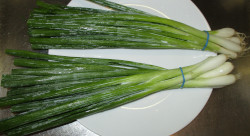 Just as onions are widely used in Western cooking, green onions (scallions) are used in many Korean dishes. They are also available at most American supermarkets.
Just as onions are widely used in Western cooking, green onions (scallions) are used in many Korean dishes. They are also available at most American supermarkets.
Korean Pepper
(한국 고추 : Hankuk Gochu)
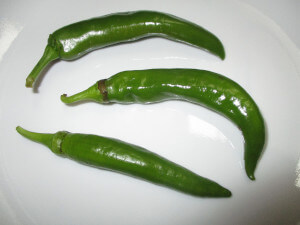 If you want to add green peppers to Korean dishes such as Doenjang Jjigae, etc., the relatively mild (but still quite hot) “Korean Peppers” are naturally the best choice. Other varieties of green peppers commonly available at Korean or American supermarkets, e.g., Jalapeno, etc., are too strong and their flavors don’t go well with the “Korean” taste you want to create.
If you want to add green peppers to Korean dishes such as Doenjang Jjigae, etc., the relatively mild (but still quite hot) “Korean Peppers” are naturally the best choice. Other varieties of green peppers commonly available at Korean or American supermarkets, e.g., Jalapeno, etc., are too strong and their flavors don’t go well with the “Korean” taste you want to create.
Korean Sweet Potato
(고구마 : Goguma)
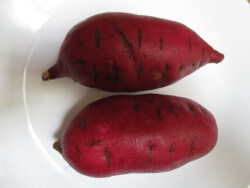 Korean sweet potato (Goguma) is usually enjoyed as a snack, although some people make side dishes out of it. If you have the patience to wait for about an hour or so while Goguma is baking in the oven, you can enjoy a nature-provided snack that tastes almost like roasted chestnuts. Our Recipes Page has the baking instructions.
Korean sweet potato (Goguma) is usually enjoyed as a snack, although some people make side dishes out of it. If you have the patience to wait for about an hour or so while Goguma is baking in the oven, you can enjoy a nature-provided snack that tastes almost like roasted chestnuts. Our Recipes Page has the baking instructions.
Tofu
Tofu
(두부 : Dooboo)
 Tofu (called "Dooboo" in Korean) is aggregated plant proteins made from soybean. Historically, tofu is a typical “temple food”, because it is a source of essential proteins for Buddhist monks who are extreme vegetarians. For this reason, tofu making has been refined throughout the centuries in Buddhist temples in Korea. In modern times, it is an everyday food item enjoyed by all.
Tofu (called "Dooboo" in Korean) is aggregated plant proteins made from soybean. Historically, tofu is a typical “temple food”, because it is a source of essential proteins for Buddhist monks who are extreme vegetarians. For this reason, tofu making has been refined throughout the centuries in Buddhist temples in Korea. In modern times, it is an everyday food item enjoyed by all.
Korean groceries have tofu in different hardness classes (Silken - Soft - Firm). The attractive soft touch that is characteristic of tofu may be best appreciated with the Silken type, but it can be a bit difficult to handle (as it breaks easily). If the ease of handling is important for you, choose a firmer type.
Tofu is packaged in plastic cartons (with some liquid) and stocked on refrigerated shelves. Unlike cheese, uncooked tofu can’t be left at room temperature for more than 1-2 hours. When you get home from grocery shopping, put tofu into your refrigerator immediately. To use tofu, open the carton and discard the original liquid. Rinse tofu briefly with cold water before using it. If you need only a portion of it, you can put the remainder in a container, fill it up with fresh cold water and store it in the refrigerator for up to a few days.
Seaweeds
Miyeok
(미역 : also spelled Miyuk)
Miyeok is a seaweed used in Korean soups and side dishes. It is sold as completely dry, crumpled mass, packaged in large plastic bags and stocked on room temperature shelves. An opened package can be stored at room temperature for many months. (Miyeok is not to be confused with Dasima.) Each time you need it, take out a small amount and soak it in cold water (for detailed methods, see our Miyeok Soup Recipe). The dried form in the package appears black, but Miyeok becomes dark green in color when soaked in water. The scientific name for Miyeok is Undaria pinnatifida.
First Picture: Dry Miyeok taken out from a package
Second Picture: After soaking in water for 20 minutes
Third Picture: Soaked Miyeok spread out on a plate to show the details
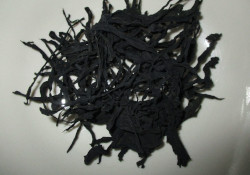
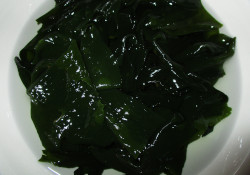
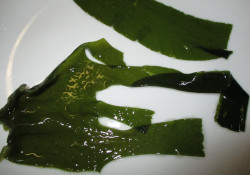
Dasima
(다시마 )
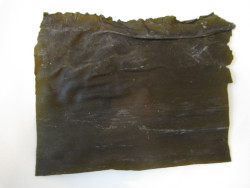 Dasima is another type of seaweed important in Korean cuisine. Although it is sometimes eaten as fried Dasima, the most common use is making soup bases (after boiling in water for a while, Dasima pieces are removed and discarded). It is sold as completely dry, flat “sheets”, which are packaged in large plastic bags and stocked on room temperature shelves. An opened package can be stored at room temperature for many months. (Dasima is not to be confused with Miyeok.) Usually, Dasima is cut by hand into palm-sized pieces before adding to water. The scientific name for Dasima is Saccharina japonica.
Dasima is another type of seaweed important in Korean cuisine. Although it is sometimes eaten as fried Dasima, the most common use is making soup bases (after boiling in water for a while, Dasima pieces are removed and discarded). It is sold as completely dry, flat “sheets”, which are packaged in large plastic bags and stocked on room temperature shelves. An opened package can be stored at room temperature for many months. (Dasima is not to be confused with Miyeok.) Usually, Dasima is cut by hand into palm-sized pieces before adding to water. The scientific name for Dasima is Saccharina japonica.
Gim
(김 )
Gim is yet another type of seaweed. This is the same material used for Sushi rolls. It is sold as paper-thin sheets (about the size of a letter size paper), which are packaged in plastic bags and stocked on room temperature shelves. Gim packages contain small sachets of desiccants (moisture-absorbing materials), which are of course not for human consumption.
In Korea, seasoned and roasted Gim is served as a side dish. Before serving, a thin coat of sesame oil is applied and salt is lightly sprinkled; then the Gim sheets are roasted by passing briefly (for a couple of seconds) over heat (e.g., kitchen range heat coil) and then cut into rectangles before serving. You take one of the pieces and put a spoonful of steamed rice; wrap it up and consume it in one bite. Or, in the wrap you can include Namul , meat and/or other Banchans (side dishes). Korean groceries sell factory prepared (oiled, salted, roasted and cut) Gim sheets, which have controlled amounts of oil and salt and are packaged in 1-meal sized foil packs.
PICTURE
Commercially prepared (oiled, salted, roasted and cut) Gim sheets taken out from a foil package
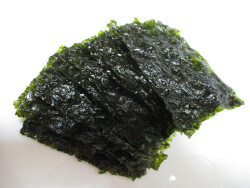
Gim is also used as flakes to add flavor to soups: a Gim sheet is roasted by passing briefly over heat and then crumpled and crushed by hand into small flakes, which are added, right before presentation, to soup dishes such as Tteokguk (떡국) or Mandoo Guk (만두국). The scientific names for the species that make up Gim are Pyropia yezoensis and Pyropia tenera.
Noodles
Somen and Kalgugsu
(소면 and 칼국수 )
Korean groceries sell many types of noodles made with various ingredients (wheat, buckwheat, etc.) both in the dry form (on room temperature shelves) and in the wet form, as fresh noodles (in refrigerated sections). Among them, perhaps most convenient and versatile ones are the dry forms of Somen and Kalgugsu. They are both wheat-based noodles but differ in thickness and shape. The picture below shows Somen and Kalgugsu in comparison with Italian spaghetti. Somen (소면 ) means “plain noodle” in Korean; it is also known as Makgugsu (막국수 ). Kalgugsu (칼국수 ) means "knife-cut noodle"; although the Kalgugsu sold in Korean groceries are machine-generated, the flat shape simulates the traditional knife-cut noodle made from hand-rolled flat dough.
You can add Somen or Kalgugsu to a variety of broth to make noodle dishes of your choice. For a beginner, however, it might be easier to start with noodle dishes like the ones introduced in our Recipes Page, which do not involve a broth.
Noodles in the Picture
Bottom (flat noodle): Kalgugsu
Middle (thin noodle): Somen
Top (darker in color): Italian spaghetti (No.5) shown for comparison
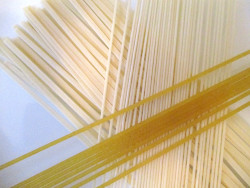
Cooking Directions:
Compared to Italian pasta, the cooking times for these Korean noodles are shorter, and there is no need to add salt to the water. Also, since Korean noodles release a fair amount of starch during the boiling step, especially near the end, a lot of starch bubbles may rise up in the pot. Each time that happens, you can add a small amount (1/4 cup) of cold water into the boiling pot to let the bubbles subside (and continue boiling).
When the boiling step is done and the hot water is drained, you need to rinse the noodle in cold running water, which is very important. If you don’t do this cold wash, the noodle will continue to cook in the residual hot water and become too soft. When you do the cold wash, do not stick your fingers into the noodle too early (the noodle remains burning hot for a deceptively long period of time even under cold running water). If you are making a cold noodle dish, you can proceed to the next step. However, if you are making a hot (warm) dish, you need to heat up the noodle again (either by putting it directly into the hot soup you are making and reheating it; or pouring a fresh batch of hot water over the noodle in a colander before adding it to the hot soup).
Starch Noodle also known as Cellophane Noodle
(당면 : Dangmyeon)
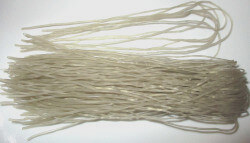 This is semi-transparent noodle, used in various Korea dishes; it is made typically with starch extracted from sweet potatoes. It is packaged in plastic bags and stocked on room temperature shelves. For cooking directions, see our Japchae recipe in the Recipes Page.
This is semi-transparent noodle, used in various Korea dishes; it is made typically with starch extracted from sweet potatoes. It is packaged in plastic bags and stocked on room temperature shelves. For cooking directions, see our Japchae recipe in the Recipes Page.
Rice Cakes
Rice Cakes for Tteokbokki
(떡볶이 : also spelled Tteok-Bokki)
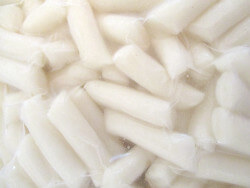 Korean groceries have two types of rice cakes used for cooking. One is cylinder-shaped; the other is oval-shaped discs. For Tteokbokki, you need the cylinder-shaped rice cakes. Both types are packaged in plastic wraps and stocked on refrigerated shelves. An opened package can be stored in the refrigerator for up to about a week. Our Recipes Page has a Tteokbokki Recipe.
Korean groceries have two types of rice cakes used for cooking. One is cylinder-shaped; the other is oval-shaped discs. For Tteokbokki, you need the cylinder-shaped rice cakes. Both types are packaged in plastic wraps and stocked on refrigerated shelves. An opened package can be stored in the refrigerator for up to about a week. Our Recipes Page has a Tteokbokki Recipe.
Kimchi
Kimchi
(김치 )
Korean groceries have several types of Kimchi in their refrigerated section.
(a) Napa cabbage Kimchi with red pepper flakes
(배추 김치 : Baechu Kimchi)
 This is the best known type of Kimchi, made with Napa cabbage (Baechu: 배추 ), red pepper flakes (고춧가루 : Gochugaru), garlic, green onion and other ingredients, which often include fermented shrimps (Saewoo Jeot: 새우젓 ) or fermented anchovies (Myeolchi Jeot: 멸치젓 ). Some jars have the Kimchi in the form of half cut cabbages; some have bite-sized slices. There is essentially no difference in taste between the two types. If you buy the unsliced type, you need to slice them on a cutting board before serving.
This is the best known type of Kimchi, made with Napa cabbage (Baechu: 배추 ), red pepper flakes (고춧가루 : Gochugaru), garlic, green onion and other ingredients, which often include fermented shrimps (Saewoo Jeot: 새우젓 ) or fermented anchovies (Myeolchi Jeot: 멸치젓 ). Some jars have the Kimchi in the form of half cut cabbages; some have bite-sized slices. There is essentially no difference in taste between the two types. If you buy the unsliced type, you need to slice them on a cutting board before serving.
(b) Radish Kimchi with red pepper flakes
(깍두기 : Kkakdugi)
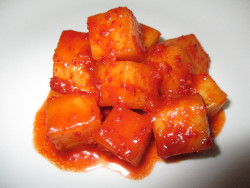 This Kimchi is made with Korean radish cut into cubes. It is seasoned with red pepper flakes (고춧가루 : Gochugaru), garlic, green onion and other ingredients, which often include fermented shrimps (Saewoo Jeot: 새우젓 ) or fermented anchovies (Myeolchi Jeot: 멸치젓 ).
This Kimchi is made with Korean radish cut into cubes. It is seasoned with red pepper flakes (고춧가루 : Gochugaru), garlic, green onion and other ingredients, which often include fermented shrimps (Saewoo Jeot: 새우젓 ) or fermented anchovies (Myeolchi Jeot: 멸치젓 ).
(c) Baek Kimchi
(백김치 )
This is a “white” Kimchi made with Napa cabbage. The color is white, because no red pepper flakes are used. It is an ancient form of Kimchi, which is still very popular in Korea.
(d) Dong-Chi-Mi
(동치미 )
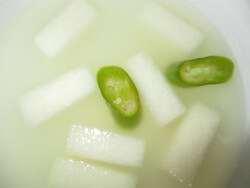 This is a “white” Kimchi made with Korean radish (not Napa cabbage). The color is white, because no red pepper flakes are used. In the container, you will see radish chunks floating in a large volume of liquid. It is another ancient form of Kimchi, which is still very popular in Korea. All types of Kimchi are best served cold, but for Dong-Chi-Mi, it is essential to serve it very cold, because it is a winter food. The refreshing liquid of Dong-Chi-Mi, often with some thin ice, taken out from a snow-covered Ong-gi (옹기 ; large earthenware vessel) is one of the fondest memories from the old Korea.
This is a “white” Kimchi made with Korean radish (not Napa cabbage). The color is white, because no red pepper flakes are used. In the container, you will see radish chunks floating in a large volume of liquid. It is another ancient form of Kimchi, which is still very popular in Korea. All types of Kimchi are best served cold, but for Dong-Chi-Mi, it is essential to serve it very cold, because it is a winter food. The refreshing liquid of Dong-Chi-Mi, often with some thin ice, taken out from a snow-covered Ong-gi (옹기 ; large earthenware vessel) is one of the fondest memories from the old Korea.
How to Enjoy Commercially Prepared Kimchi at Its Prime
If you like Kimchi and want to enjoy it at home, the simplest way is to buy Kimchi at a Korean grocery. (Nowadays, some American grocery chains also carry Kimchi.) But, simply picking up a jar of Kimchi at a grocery is not enough – if the Kimchi in the jar is not yet ripe, you need to ripen it. This section explains how.
Kimchi is a fermented food like wine. Kimchi begins its life as a “raw salty salad”, which is not yet Kimchi, just as the initial stage of wine (a grape juice-like liquid) is not wine. The Kimchi you purchased at a store may not be ripe. Or, depending on how many days it has spent in the grocery’s refrigerator, it may happen to be just at its peak of taste or past that point.
When you arrive at home from grocery shopping, put the Kimchi jar in the refrigerator. However, you should definitely taste a small piece as soon as possible. There are 3 different possibilities.
At Its Prime: If you’re lucky, it may be at or near its prime, with the characteristic “carbonated” taste that is refreshing and, at the same time, slightly sour. If that’s the case, enjoy it today. Keep the remaining portion in the refrigerator. When refrigerated, the “perfect” condition will last about a day (yes, it’s short-lived). After that, the taste will remain “very good” for a couple of days.
Korean families usually have several jars of Kimchi prepared on different dates, so that they can enjoy Kimchi at its prime more frequently than not. Also, many of them use special “Kimchi Refrigerators”, which maintain a colder temperature than ordinary refrigerators.
Unripe: It is possible that your Kimchi is not quite ready yet, which means you can’t eat it today. Then the question is: how long should I wait? That’s the tricky part. In a refrigerator, it may take a couple of days, a week or longer before it reaches the peak of taste. If you don’t want to wait that long, you can take it out of your refrigerator and leave it at room temperature for a while. But you need to be careful. At room temperature, the “Kimchi clock” ticks very fast, and you may end up over-ripening it, especially if your Kimchi has already been somewhat ripe or if the weather is warm. Ideally, do it under your watch for several hours or, if your Kimchi tastes quite raw, half a day. Then taste a piece again to decide whether to put the jar back into the refrigerator. It’s important to let your Kimchi reach the point of peak taste in the refrigerator, not at room temperature. (If it reaches its prime outside of the refrigerator, by the time the jar is fully cooled down again, it may already be past prime, because the jar doesn’t cool down immediately in the refrigerator.) Another thing to keep in mind is that, as Kimchi gets ripe, it generates carbon dioxide, the same gas that is in soda – that’s why well ripe Kimchi has a “carbonated” taste. When left at room temperature, a lot of carbon dioxide may be generated inside the jar over a short period of time, and the liquid may spill over (abrupt bubbling may occur as if you opened a soda can after shaking). When you try quick ripening of Kimchi at room temperature, be prepared for the spillover (do not over-tighten the lid; and keep the jar in a plastic bag, so that a spillover won’t create a mess).
Over-ripe: If your Kimchi is over ripe, it tastes as acidic as sauerkraut. Some people love sour Kimchi, but some don’t. It’s not possible to undo it, but there are traditional Korean recipes that specifically call for sour Kimchi. These are perfect ways to make most out of your past-prime Kimchi. Two examples are given in our Recipes Page: Kimchi Jeon and Kimchi Noodle.